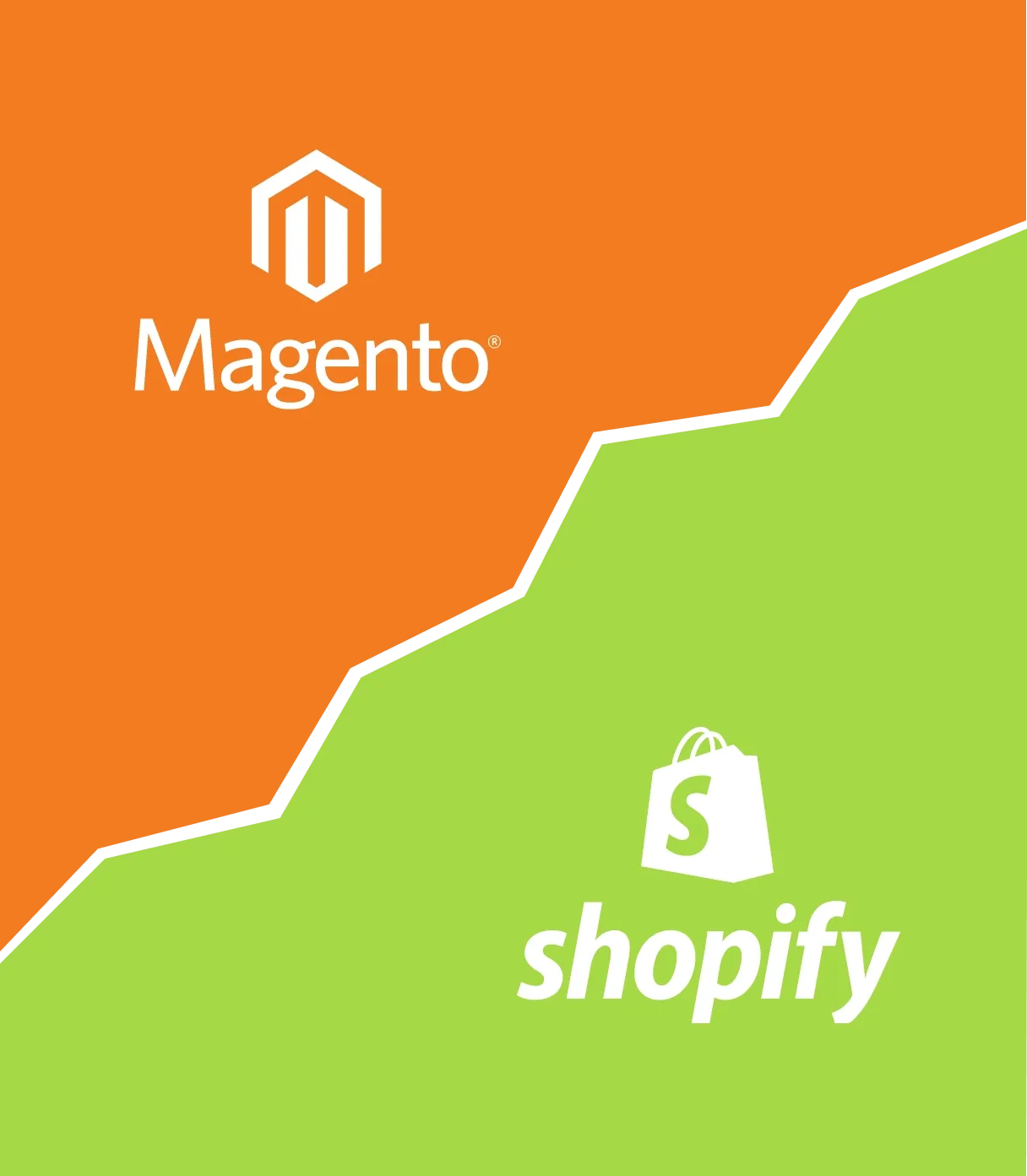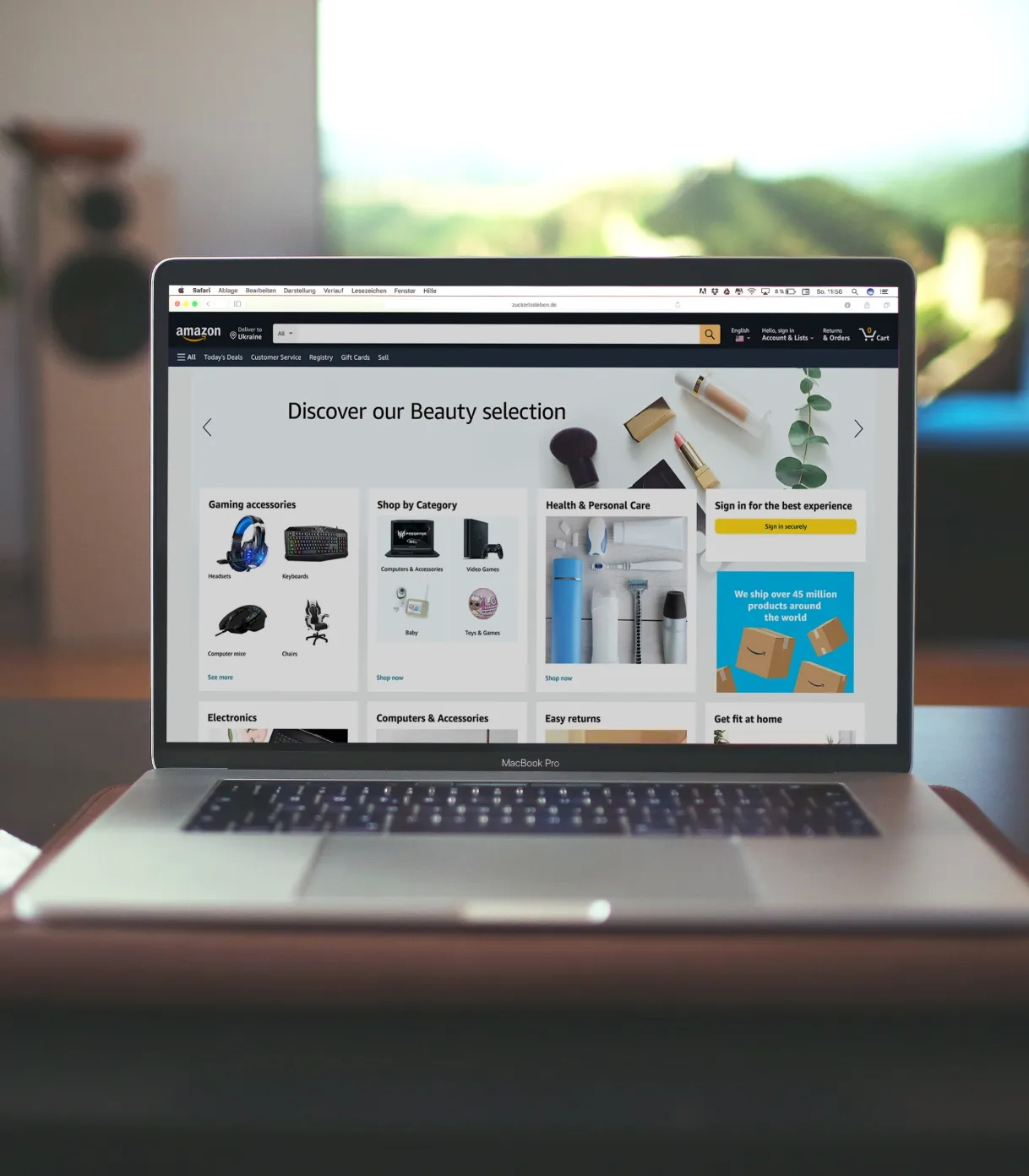
Two major platforms dominate the ecommerce space, both letting merchants sell products and offer tools and resources for a monthly fee. But which is better to sell on: Amazon or Shopify? This article compares these two options to help you choose the best platform for your online store. So, which will it be?
Keep reading to discover what our research reveals—you might be surprised by the results!
Platforms overview: Shopify or Amazon
To define the difference between Shopify and Amazon, we need to discover their main features and functionalities. Amazon is an online marketplace where you sell alongside other sellers, while Shopify is a dedicated ecommerce platform where you create and manage your own online store.
Selling on Amazon is like having a booth at a bustling street market. You’re surrounded by many other sellers, and while you benefit from the high foot traffic, customers may not be specifically looking for your brand. On the other hand, selling through Shopify is more like renting your own storefront. Customers who visit your Shopify store are actively looking for your brand, giving you the chance to build a unique brand image. Although it requires more effort to attract and retain customers, you have more control over your brand’s presence.
Amazon vs. Shopify – See the comparison:
| Feature | Shopify | Amazon |
|---|---|---|
| Platform type | Website builder and host | Third-party marketplace |
| Pricing | Basic ($32/month), Shopify ($92/month), Advanced ($399/month), Shopify Plus (from $2,300/month) | Individual plan: $0.99 per item sold, Professional plan: $39.99 per month |
| Templates and design | Equipped with an online web builder and a diverse collection of professional and free templates for various industry types | Limited customization capabilities |
| Marketing options | Social media integration, gift cards, discount codes, Google Ads credits | Amazon paid ads, competitive pricing |
| Transaction fee | Zero percent on all plans if using Shopify Payments. If using an external payment gateway: 2% for Basic; 1% for Shopify; 0.6% for Advanced; 0.2% for Plus | All sellers must pay a referral fee based on the product category |
| Mobile-friendly | Yes | Yes |
| Customer support | 24/7 live chat, email, and phone support | Amazon Seller Support team |
Shopify offers over 100 professionally designed themes that you can customize to fit different types of businesses, from sports to clothing. Its easy-to-use web builder makes it simple for beginners to set up their store. Getting an Amazon Seller account is free with the Individual plan. While you can’t build a custom storefront like you can on Shopify, you do have control over your product images and descriptions. However, because your products are shown next to those of other sellers, it can be harder to grab customers’ attention.
These differences between Shopify and Amazon make the first one suited to various kinds of sellers. Amazon is ideal for individual sellers and small to medium-sized businesses seeking high exposure. Shopify is better for small to large enterprises that want to create a distinct online presence and build a loyal customer base.
Shopify vs. Amazon: Pros and cons recap
Now before thoroughly discovering the key differences between Amazon and Shopify, let’s review their pros and cons.
Pros of Shopify
-
Store ownership: You fully own your online store, giving you control over sales, customer data, and marketing strategies.
-
Extensive customization options: Shopify offers a wide range of tools to personalize your store and build a distinctive brand.
-
Built-in marketing tools: Shopify provides all the tools you need to market your business effectively from one platform.
Cons of Shopify
-
Learning curve: It’s easy to use, but there’s a lot to learn at the start.
-
Traffic responsibility: You need to drive traffic to your store yourself through marketing and SEO efforts.
Pros of Amazon
-
Large customer base: Amazon gives you access to a massive audience of millions of potential buyers.
-
Easy setup: Setting up an Amazon store is quick and simple.
-
FBA services: Amazon’s Fulfillment by Amazon (FBA) handles shipping and storage for you.
Cons of Amazon
-
Limited customization: You can’t personalize your store as much, so it’s harder to stand out.
-
High competition: With many sellers on Amazon, it’s competitive and challenging to attract customers.
Shopify vs. Amazon: Pricing
Shopify pricing has a simple and predictable subscription-based structure, while Amazon’s pricing is more complex and varies based on factors like sales volume, product category, and fulfillment services. Let’s break down how pricing works for both Shopify and Amazon.
Shopify plans: Which is best for you?
Shopify offers a 3-day free trial, which can be extended to $1/month for the next month. It’s a great chance to explore the platform. After the trial, you can select from four pricing plans based on your business needs (paid monthly):
-
Basic plan: $32/month, with a 2.9% credit card processing fee, a 2% fee for third-party payment providers like PayPal or Stripe, 24/7 chat support, and 10 inventory locations.
-
Shopify plan: $92/month, with a 2.6% credit card processing fee, a 1% fee for third-party payment providers, 5 additional staff accounts, standard analytics, and custom APIs.
-
Advanced plan: $399/month, with a 2.4% credit card processing fee, a 0.6% fee for third-party payment providers, 15 additional staff accounts, enhanced live chat, and custom reports and analytics.
-
Shopify Plus: from $2,300/month, with a 0.2% fee for third-party payment providers, designed for large stores handling thousands of orders daily.
All plans include web hosting and an option to connect a custom domain, though the domain must be purchased separately. Note that these plans do not cover order and fulfillment services. While Shopify integrates with various third-party fulfillment providers, costs for storage, picking, packing, and shipping are additional expenses separate from your Shopify plan.
Amazon offers two plans – Individual and Professional. The Individual plan costs $0.99 per item sold, while the Professional one costs $39.99 per month.
Choose Individual if you:
- Sell up to 40 products per month
- Have no need of sales programs or advanced tools
- Are still in the process of selecting the products you’ll sell
Choose Professional if you:
- Sell over 40 products per month
- Want access to the API and additional sales reports
- Want to sell through programs like Handmade or Launchpad
It should be noted that by choosing the Professional plan, you’ll only pay the monthly subscription fee ($39.99), regardless of how many items you sell. You won’t pay $0.99 for each sale. But there are still other fees to consider, like referral fees, which take a cut of every sale – anywhere from 6% to 45%, depending on what you're selling. Plus, if you use Amazon's Fulfillment by Amazon (FBA) service, there are extra charges for storage, picking, packing, shipping, and even handling returns. These costs can add up, especially if your products are large or heavy.
With Shopify, you pay a flat monthly fee, and no per-item fees. But on the flip side, the platform doesn’t include fulfillment in that price, so you’ll need to handle shipping yourself or use a third-party service. Besides, don’t forget – Shopify doesn’t drive traffic to your store like Amazon does. So, while Shopify has lower fees, you'll need to put in the work to generate sales.
To put it short, Amazon's FBA is great because it handles all the shipping and storage for you, but it can get pretty expensive. If you want to keep things simpler and have more control over your costs, Shopify might be a better fit. Its pricing is straightforward, which can be helpful as your business grows.
Customization capabilities
Is Shopify better than Amazon? Let’s explore how these two platforms stack up against each other in terms of customization capabilities.
A strong brand helps you sell products and attract new customers. When choosing an ecommerce platform, check how well you can customize your store to match your brand. Still hesitating concerning the question, ‘Should I sell on Shopify or Amazon’, let’s move forward.
Shopify offers more advanced customization and branding options than Amazon, allowing you to add your brand’s colors, logos, fonts, and images.

Shopify also provides options to create pop-ups, add social media embeds, and use custom CSS to personalize your store. Content is your key way of building brand authority and engaging with your audience. Shopify includes a built-in blogging platform and an AI assistant to help you generate content effectively.
All in all, with Shopify, you get full control over their online store and a wide range of customization features to design a brand exactly how you want.
Compared to Shopify, Amazon offers fewer options for brand customization. While you can register your brand on Amazon if you have a trademark, customization options are limited. You can add branded images and adjust product descriptions, but your product listings will still look the same as others and have limited opportunities for distinct branding.
Building a brand on Amazon can be tough, especially for beginners. Selling on Amazon vs Shopify might be easier because Amazon is well-known, has a huge customer base, and is trusted by many. However, since Amazon is a third-party marketplace, you don’t own your product listings or customer information, and you could be kicked off the platform if you don’t follow their rules.
Selling on Amazon vs Shopify: Which one is best for SEO?
Shopify has many tools to help your store rank higher in search results. These include auto-generated sitemaps, 301 redirects, customizable title tags and meta descriptions, and a built-in blogging platform.
On Amazon, you can only add a few keywords to your product titles and descriptions. However, because Amazon is a huge, well-known platform with high domain authority, it ranks well in search results and attracts a lot of free organic traffic.
Moreover, Amazon's search engine gives priority to "Prime" products. If you use Amazon's FBA, your products will be labeled as "Prime" and will rank higher in search results.
The power of marketing tools
So, how is Shopify different from Amazon in terms of marketing tools? Shopify's built-in marketing tools let you create and manage ad campaigns, social media posts, automated messages based on conditions, and SMS notifications. You can easily design and track the performance of your campaigns all from a single dashboard.
Shopify also offers email marketing tools with easy-to-use templates for creating ads. Plus, you can use hundreds of Shopify Apps to add extra features and optimize your store. Check out the Shopify App Store to find tools that can help grow your site.
Let's talk about discounts, which are great for attracting more customers. Shopify lets you create and manage sales and discount coupons in various ways, giving you the flexibility to choose when to run promotions. In contrast, Amazon has set conditions for discounts, so you have less control over when and how you can offer them.
In short, Shopify gives you everything you need to connect your favorite marketing tools and make promoting your brand easier.
How Shopify and Amazon stack up in customer support and resources
To build and grow an online store, you’ll often need help from your ecommerce platform provider. Let’s see how Amazon differs from Shopify when it comes to customer support.
Shopify’s support
Shopify works hard to help its users succeed. They offer lots of useful blog posts, guides, and courses on topics like SEO, social media, and email marketing. You’ll also find updated business plan templates to help you grow.
Shopify also provides handy tools like a QR code generator and a "Link in Bio" feature, so you don’t need to find extra services. Their customer support is superior to Amazon’s, offering a personalized AI chatbot in their help center to answer specific account questions.
Additionally, Shopify gives 24/7 live chat support, as well as a range of useful resources, including courses, to help you build a successful online business.
Amazon support
Getting support from Amazon can be harder than getting help from Shopify. To contact an expert, you have to fill out a form indicating your problem and providing contact info. This can be tricky, especially taking into account that you may need assistance quite often.
You'll find plenty of useful resources, though. Amazon offers well-organized help materials and Amazon Seller University to guide you in selling effectively through the marketplace.
Order fulfillment
Amazon FBA handles your inventory and orders, so you don’t have to. Individual seller accounts can store up to 10 cubic feet of products, while professional accounts have no limit. Fees depend on the product’s weight, size, type, and where it’s sold.
Shopify also offers a fulfillment service, but it’s not as advanced as Amazon FBA. However, you can use Amazon FBA with Shopify even if you’re not selling on Amazon itself. Intrigued? More on this below.
Why not use both? Integrating Shopify and Amazon
If you’re still hesitating which is better: Shopify or Amazon, there’s a potential solution: integrating your Shopify store with Amazon. This decision can boost your reach and profits. By integrating Shopify with Amazon, you can enjoy the best of both worlds:
-
Build a unique brand: Use Shopify’s customization options to create a branded store.
-
Outsource fulfillment: Take advantage of Amazon’s FBA to handle order fulfillment for you.
-
Expand your reach: Use Shopify’s marketing tools along with Amazon’s vast audience to drive more sales.
How to integrate Shopify with Amazon?
- Install the app: Get the free Shopify Marketplace Connect app from the Shopify app store.
- Set up the connection: Follow the app’s setup instructions to link your Shopify store with Amazon.
The app itself is free to install, but if you get over 50 orders from other marketplaces, you may have to pay a 1% fee. Even with this fee, connecting Shopify with Amazon lets you handle all your orders in one place, making it easier to see how well you’re doing each month.
Wrapping up
Still, thinking about: should I use Shopify or Amazon? Both Shopify and Amazon help ecommerce entrepreneurs set up their websites, but there are key differences. Shopify is great for those who want to build a unique online store and brand, making it ideal for selling exclusive products. Amazon, however, is easier to start with; you just need to create an account to sell new or used items. The right choice depends on your long-term goals for your online business.
If you believe Shopify matches your goals and needs best, DigitalSuits’ team is here to assist you. We are a trusted Shopify development company, specializing in designing, developing, optimizing, and launching custom Shopify stores, or migrating your existing store from another ecommerce platform. Feel free to [contact us](https://digitalsuits.co /blog/shopify-vs-amazon-which-one-should-you-choose/#contact-us) and discuss your Shopify project.













Was this helpful?
0
No comments yet